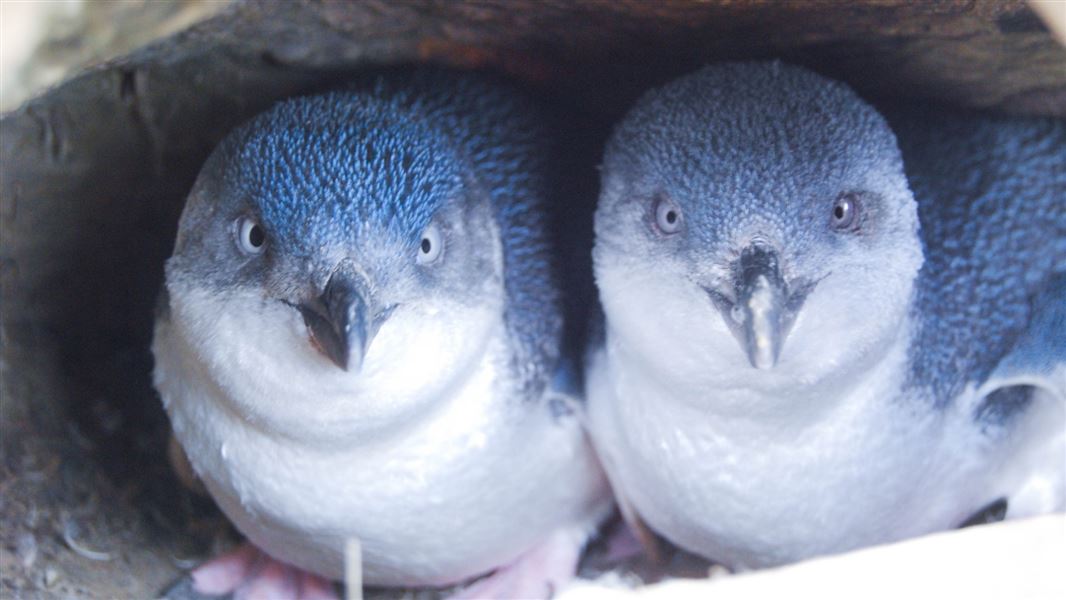New Zealand status: Native
Conservation: At Risk–Declining
Threats: Dogs, predation, road kills
Species information: Little penguin on NZ Birds Online
This species used to be called little blue penguin.
Peek inside a little penguins/kororā nest
During 2020 a 24/7 live stream brought viewers into the lives of a nesting pair of little penguins/kororā. You can see video highlights of the pair preparing for the breeding season, incubating eggs and caring for their chicks.
These birds are easily disturbed by humans, so a live stream is a perfect way to experience them up close while giving them the space they need.
Kāpiti Coast Biodiversity Project and Groundtruth with support from DOC and Air New Zealand set up the live stream. It streamed the entire breeding season from August to December 2020, when the chicks fledged and left the nest.
Little penguin/kororā conservation
Declining populations
Little penguins were common in New Zealand, but most are now on offshore islands where there is less disturbance.
Did you know?
Their paddle-like flippers are excellent for ‘flying’ through the water at speeds of up to 6 km/h.
Their population and range of has been declining in areas not protected from predators. Where predator control is in place, populations have been stable or increasing.
Dogs are likely the greatest threat to little penguin. Cats, ferrets and stoats will also kill them.
These threats have increased with more coastal development bringing more dogs and the clearance of traditional nesting sites.
Little penguins are also killed crossing coastal roads, being hit by boats, or caught in set nets.
Penguin deaths: how much is normal?
Why they come ashore
Adult birds come ashore between May and June to prepare nests. They may waddle up to 1.5 km from the sea, and climb 300 m to find the perfect nest site.
Traditional nests are in underground burrows, under vegetation, in crevices, between rocks or in caves. Since people came onto the coastal scene, little penguins have also taken to nesting under houses and boat sheds, in stormwater pipes, and stacks of timber.
Adults also come ashore to shed their feathers and grow a new waterproof coat. This moult period lasts about two weeks and can happen any time between November and March. The penguins are especially vulnerable at this time as they cannot swim.
Where to spot penguins
By day little penguins are out at sea, fishing and feeding, or in their burrows roosting, moulting or tending eggs or chicks. They are more likely to be seen in sheltered harbours and inlets where they may be spotted from a boat.
They are rarely seen on land, and generally only come ashore under the cover of darkness.
You may join an organised tour to see little penguins at Oamaru, Taiaroa Head, and recognised observation spots at other coastal sites.
From May to June, when birds are pairing up and sorting out nests, they are very noisy. You can sometimes hear them if you visit the coast just after dusk.
Many penguins in Wellington harbour have been banded, providing valuable information about their movements and lifespan. We now know that birds do not often move far from home. When ready to breed, many young animals settle just metres from where they themselves were raised. And once settled in an area, they seldom move away.
Protection and research
Little penguins are protected by the Wildlife Act, which is administered by DOC.
DOC has helped community groups by fencing off areas and providing nest boxes for penguins.
A research project was carried out as part of the National Marine Reserves Monitoring and Reporting programme, funded by DOC's partnership with Air New Zealand. Read the Little penguin behaviour and ecoystem health factsheet (PDF, 8,530K)
You can help
Keep our penguins safe
- Leave penguins alone. Usually scruffy birds are simply moulting.
- Put your dog on a leash around penguin areas.
- Keep your dog away from nests, and warn others nearby of the location.
- Donate your time or money to help penguin protection groups, such as the Yellow-eyed Penguin Trust and Forest & Bird.
If you find a dead or injured penguin
If you find a dead penguin, leave it alone. Community groups regularly count dead seabirds and will remove them from beaches.
If a sick penguin is at risk from attack by dogs or other predators, place it under vegetation in the rear-dune well away from people. Or you can take it to a local bird rescue centre.
Do not give emaciated penguins food. The rehabilitation of seabirds requires specialist knowledge and training.
If a penguin is clearly injured or in immediate danger, contact the emergency hotline 0800 DOC HOT (0800 362 468). Try and give the exact location and take photos to help us make an assessment.
Help penguins at your place
People and penguins like to live in the same places – prime coastal habitat – and penguins still try to live with people.
But what if you don’t want noisy penguins nesting under your house?
- Little penguins often return to where they hatched. In late March to April (before the breeding season), you should block up access points under your house.
- Check you haven’t blocked a bird in, or separated a parent from its chicks. It is risky to block penguins’ access while they are nesting or moulting (from May to early March), as you may trap birds under the house. Also, by sealing them out, you may expose a moulting bird to predators.
- Consider providing a nest box elsewhere on your section.
